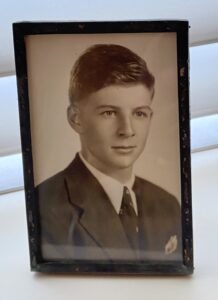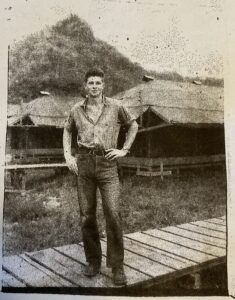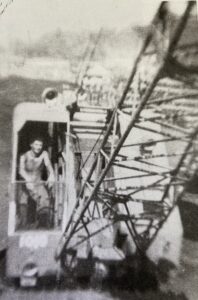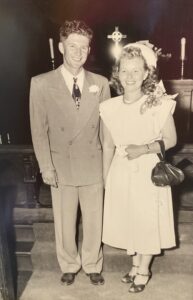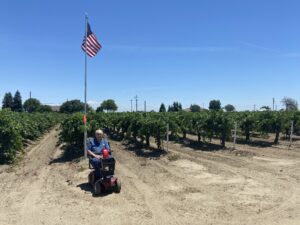Wife’s Photo In Vet’s Locker Before He Knew Her
*IN MEMORIAM*
Doug Johnson passed away April 25, 2022 at the age of 98. Click here for his obituary from the Fresno Bee.
Use controls above or click here to open this Hometown Heroes podcast in a new window
97-year-old Doug Johnson of Fresno, CA appears on episode #685 of Hometown Heroes, airing June 12-17, 2021. A native of Los Angeles, Johnson operated heavy equipment as part of an Advanced Base Supply Depot in the Philippines during World War II.
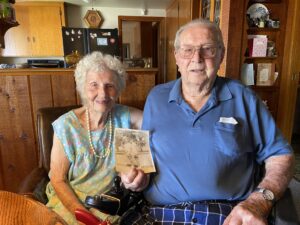
Mary Ann & Doug Johnson after 73 years of marriage. For more photos, visit the Hometown Heroes facebook page.
Doug’s grandfather was a sculptor who claimed MGM’s lions among his handiwork. His father was an architect whose prolific list of projects included the building now known as Warnors Theatre in Fresno. That family legacy of creativity has been on display throughout Doug’s 97 years as a builder, farmer, and innovator, among other outlets. One of his most vivid childhood memories from southern California is how he experienced the famous Long Beach earthquake on March 10, 1933.
“My dad got us all down on the ground floor and out into the parking lot,” you’ll hear Johnson recall of that 6.4-magnitude temblor. “We were watching the transformers swinging back and forth on the power poles.”
120 people died as a result of the earthquake, which destroyed 70 southern California schools. The widespread damage exacerbated the economic realities of the Great Depression, and left the Johnson family depending on government assistance. Young Doug sold magazines, delivered newspapers, and found any way he could to make money, even if it was a penny at a time. He attended Hollywood High School before a boundary change sent him to Fairfax High School. Listen to Hometown Heroes to find out why he had to negotiate with the principal in order to graduate in January 1942. His high school years also featured lengthy farming assignments in Fresno, for which he received school credit, and you’ll also hear him remember the three agricultural classes he completed at Fresno State College in 1942. His recollection might make you wonder whether he was a student or the instructor for those classes. Doug wanted to enlist in the Army Air Corps to put his mechanical skills to use in repairing and maintaining aircraft, but he was told that his work on the farm necessitated a strategic agricultural deferment. Two years later, he was able to join the military, but you’ll hear Johnson explain how he had to invoke his grandfather’s background as a sea captain in order to capture an ensign’s attention and secure a spot in the Navy, not the Army.
You’ll hear how his hog calling experience back on the farm came in handy during his early days of Navy training in San Diego, and also how an ankle injury suffered while playing handball created a detour along his Navy journey. Four months of electrical school in Gulfport, MS preceded his being sent to an Advanced Base Supply Depot. With that new assignment came the opportunity to practice amphibious landings in Coronado, CA, with the understanding that the simulated role of placing banners on the beach to direct LSTs to landing zones is something he would be doing for real in the planned invasion of Japan.
“It was going in with the first wave of the Marine Corps,” you’ll hear him explain. “No guns, just the banners. So it was really, I’d call it a suicide mission.”
After two months of that training, he headed overseas, but his destination was the Philippines, where Doug ended up operating the biggest crane the Navy had. You’ll hear him relate how he seized that opportunity, as well as the very valid reason he once had for disobeying a Navy captain’s direct order to drive that crane out on a pier. He spent some time in Tacloban on the island of Leyte, followed by the Naval Supply Depot at Subic Bay on the island of Luzon. While he was never subjected to enemy fire, he did draw the duty of driving a truck loaded with live bombs, later witnessing a reminder of how dangerous that duty could be. The threat of typhoons was another unnerving factor, but the only hazard that landed Johnson in the hospital was malaria.
“It took two corpsman to pick up the rubber sheet and pour the water off,” he says of the sweat that piled up during a six-day bout with malaria that saw his temperature skyrocket to 106 degrees. “I weighed 206 pounds and I ended up at 158.”
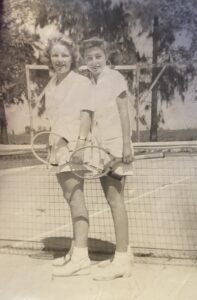
This photo of his sister, Patricia (right), was in Doug’s locker during his entire time overseas. Little did he know the young woman on the left would become his wife.
Throughout the time Doug served overseas, he kept a photograph of his sister, Patricia, in his locker. Also depicted in the photo was one of Pat’s tennis teammates, a young woman whom Doug had never met. While working on a building project after returning home from the war, he went to pick up a check from the man who had hired him, only to see a familiar face open the door. You’ll hear the story of how Doug & Mary Ann finally connected on Hometown Heroes, and it’s also captured in the video below:
On June 10, 1948, Doug and Mary Ann exchanged their wedding vows. 73 years later, their marriage endures, with gratitude for the memories made with three children and the grandchildren and great-grandchildren who have followed. Doug’s appreciation for Mary Ann’s contributions as he built 13 homes, and her ongoing partnership in growing organic Zante Currant raisins, parallels the respect he carries for those who helped win World War II with their efforts on the home front.
“Where would we have been without the civilian dedication?” you’ll hear him ponder. “They were as important to me as my job. All I was doing was stacking what they had built.”
The examples of women and other civilians who supported the war effort in any way they could underscores for Doug that the singularity of purpose articulated in the name of our country was evident in the actions and attitudes of the American populace during World War II.
“We fought a war of united people,” you’ll hear Johnson explain. “I fly the flag 24 hours a day for the simple reason that it represents the United States.”

